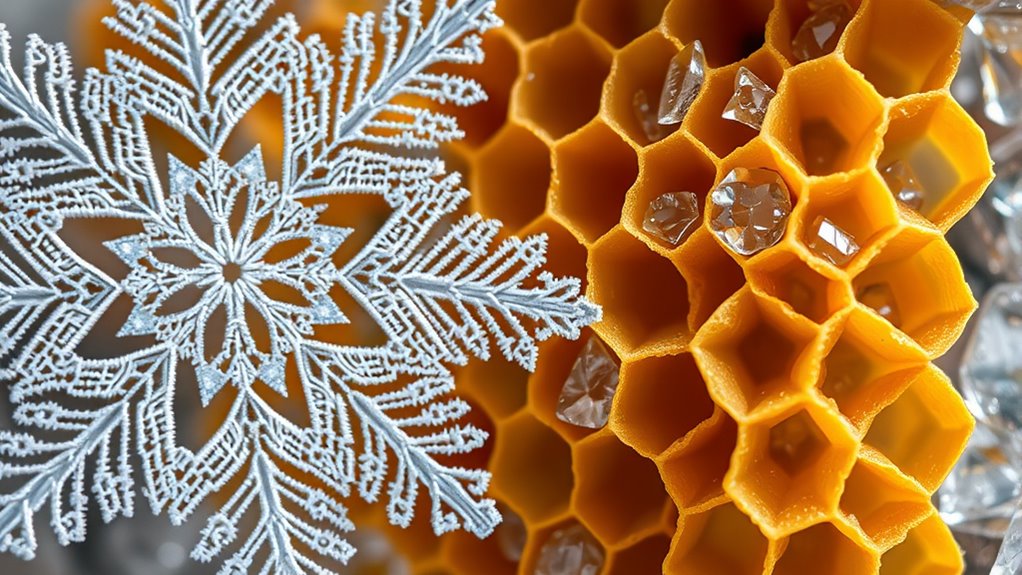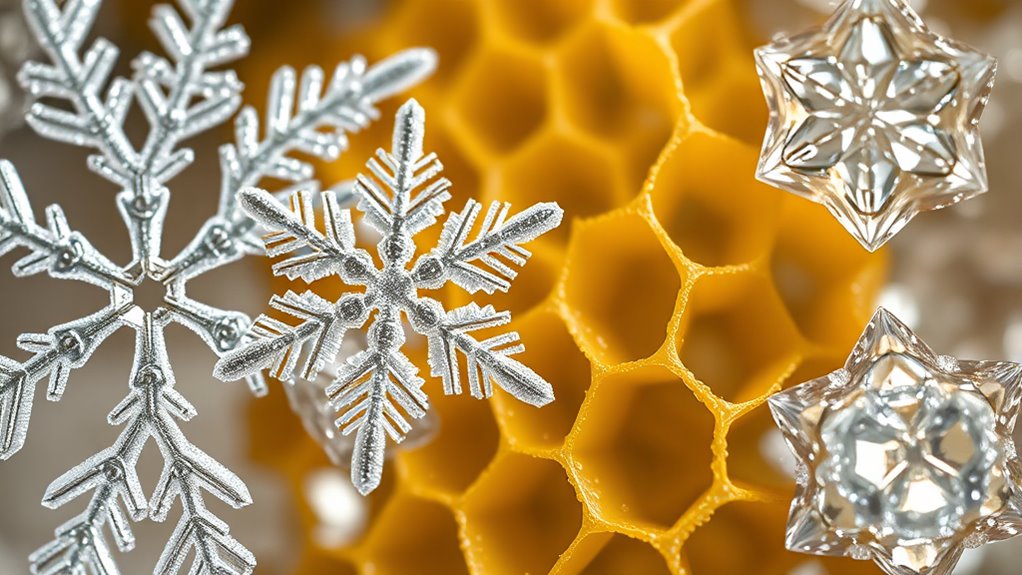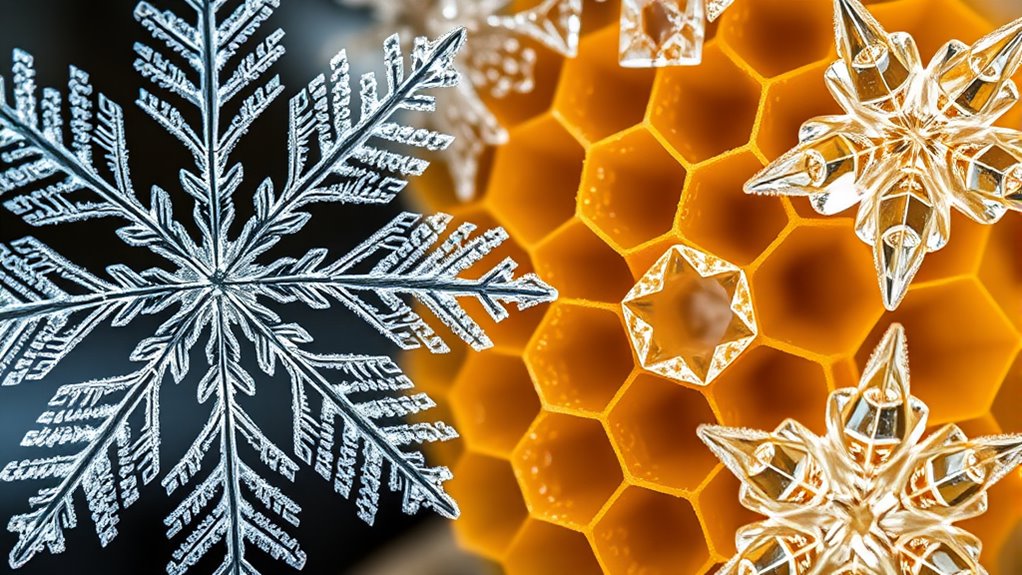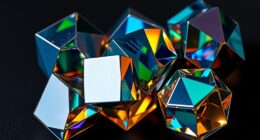You can see nature’s incredible use of geometry in snowflakes, honeycombs, and crystals. Snowflakes show perfect hexagonal symmetry and fractal patterns, while honeycombs optimize space and strength with their hexagonal shapes. Crystals form intricate, repetitive structures based on molecular arrangements, exhibiting symmetry like cubes or octahedrons. These patterns demonstrate how nature uses geometry to create beauty, efficiency, and stability—if you keep exploring, you’ll uncover even more fascinating details behind these natural designs.
Key Takeaways
- Snowflakes exhibit hexagonal symmetry and fractal patterns, showcasing self-similar and recursive geometric designs influenced by environmental conditions.
- Honeycombs use hexagonal tessellations to maximize space efficiency, strength, and resource conservation through geometric optimization.
- Crystal structures form based on molecular lattice arrangements, creating repeating geometric units with specific symmetry elements.
- Nature employs hexagonal symmetry, fractals, and recursive patterns to create complex, stable, and efficient structures in snowflakes, honeycombs, and crystals.
- Geometric principles in nature demonstrate how molecular arrangements and symmetry lead to aesthetically intricate and functionally optimized forms.
The Symmetry of Snowflakes

Snowflakes display intricate symmetry that reveals nature’s geometric precision. As you observe, you’ll notice their fractal patterns, where each branch mirrors the others in a self-similar way. This recursive design creates complex structures from simple rules, demonstrating nature’s ability to generate detailed beauty through repetition. The core shape of most snowflakes exhibits hexagonal symmetry, meaning they have sixfold rotational symmetry around a central point. This geometric trait results from the molecular arrangement of ice crystals, which naturally forms into hexagonal lattices. Each snowflake develops unique patterns while maintaining this fundamental symmetry, showcasing the elegant balance between randomness and order. Understanding snowflake formation highlights how temperature and humidity influence their intricate designs. The combination of fractal patterns and hexagonal symmetry highlights how nature employs geometry to craft the delicate, mesmerizing forms of snowflakes.
The Geometry of Honeycombs

The intricate symmetry seen in snowflakes extends into the natural design of honeycombs, where geometry plays an essential role in their structure. Honeybees create hexagonal tessellations, which maximize cellular efficiency by using the least material for the most storage space. This geometric pattern offers strength and stability, allowing the comb to withstand external forces. Regular assessment and rotation of items can help maintain the structural integrity of such systems by preventing clutter buildup. Here are three fascinating facts:
Honeycombs use hexagons for strength, efficiency, and resource conservation.
- Hexagonal tessellations are the most efficient way to cover a plane without gaps.
- The honeycomb’s shape minimizes the amount of wax needed, conserving resources.
- The uniformity of the hexagons ensures even distribution of structural stress.
This geometric precision showcases how nature optimizes space, strength, and resource use effortlessly.
Crystal Structures and Geometric Patterns

Crystals form intricate geometric patterns that reveal nature’s precision and order. Their molecular lattice structures create repeating arrangements, giving rise to stunning mineral formations. These patterns follow specific symmetry and angles, resulting in unique shapes like cubes, hexagons, and octahedrons. The arrangement of atoms within a crystal determines its overall shape and properties. Variations in environmental conditions influence crystal growth, producing diverse structures. Additionally, understanding crystal symmetries helps scientists predict and replicate mineral formations. Below is a visual overview:
| Molecular Lattice | Mineral Formation |
|---|---|
| Repeating units | Geometric symmetry |
| Atomic pattern | Crystal shape |
| Symmetry elements | Growth conditions |
| Tetrahedral | Mineral diversity |
| Hexagonal | Natural geometries |
Understanding these structures helps explain the beauty and stability seen in mineral formations and their geometric precision.
Frequently Asked Questions
How Do Snowflake Patterns Change With Temperature?
You might wonder how temperature effects snowflake patterns, and the answer is that it substantially influences their structural diversity. As temperatures drop, snowflakes tend to develop more intricate and symmetrical designs because colder air promotes complex crystal growth. Conversely, warmer conditions often produce simpler, more irregular shapes. So, by changing temperature, you directly impact the complexity and beauty of snowflakes, showcasing nature’s fascinating ability to adapt its geometric patterns.
Are Honeycomb Structures Found in Animals Other Than Bees?
Imagine a master architect designing tiny, perfect hexagonal rooms—honeycomb structures. You’ll find such patterns in animals beyond bees, like wasps creating their own intricate nests with wasp cells. These hexagonal designs maximize space and strength. Other creatures, like certain ants and even some birds, use similar geometrical patterns in their nests or shelters, showcasing nature’s love for efficient, beautiful structures that resemble a bee nest or wasp cells.
What Role Do Geometric Patterns Play in Mineral Formation?
You might wonder how geometric patterns influence mineral formation. When minerals crystallize, their atoms arrange into a mineral lattice, creating highly organized structures. This process results in geometric symmetry, which determines the shape and appearance of crystals. As you observe mineral growth, you see how these patterns guide the formation, making each crystal uniquely beautiful yet governed by natural geometric principles.
Can Crystal Structures Influence Biological Processes?
Sure, crystal structures can influence biological processes, even if it seems ironic that lifeless minerals shape life itself. You might not realize that molecular symmetry and lattice dynamics in crystals affect how cells interact and grow. These structures guide protein formation and enzyme activity, subtly directing biological functions. So, yes, the geometric elegance of crystals plays a surprisingly essential role in the complex dance of life.
How Does Environmental Variation Affect Natural Geometric Formations?
You see, environmental variation impacts natural geometric formations by exerting environmental pressures that shape their development. These pressures drive organisms to adapt their structures, often following adaptive geometric algorithms to optimize survival. As conditions change, these algorithms guide the formation of patterns like leaf arrangements or shell structures, ensuring they efficiently respond to their environment. Fundamentally, environmental variation directly influences how natural geometries evolve and maintain their functional integrity.
Conclusion
So, next time you marvel at a snowflake or admire a honeycomb, remember—they’re not just pretty shapes. They’re nature’s way of proving that perfect symmetry and geometric design have a sense of humor. You’d think these complex patterns would be crafted by engineers, right? But nope, nature’s just winging it—creating stunning structures that make us wonder if beauty really is just chaos with a touch of order.





